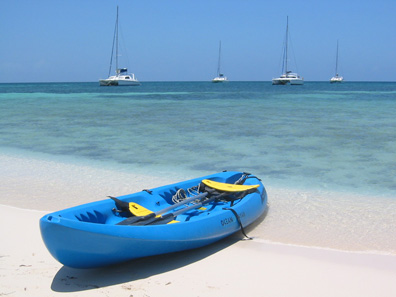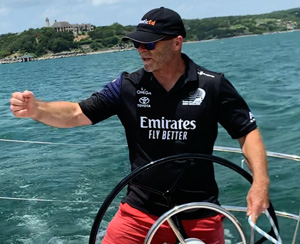NauticEd Navigator gives you personalized
course recommendations based on your
sailing goals and experience
Chart a Course to Your Sailing Future
 Select my goals
Select my goals NauticEd Navigator gives you personalized
course recommendations based on your
sailing goals and experience
 Select my goals
Select my goals
The Bareboat Charter online sailing and powerboating course is your go-to resource for planning an unforgettable charter vacation. Whether you're dreaming of cruising the Caribbean, Mediterranean, or any other destination, this comprehensive course equips you with all the necessary skills and knowledge to successfully charter a yacht. From navigating the charter base to managing energy and troubleshooting, learn from the experts and ensure a smooth and enjoyable bareboat charter experience. Perfect for boaters of all levels, enroll now to make the most of your next sailing or powerboat adventure with NauticEd.
Estimated Time: 5 hours
Price: $39 (or $33 with the Bareboat Charter Master Sailboat Bundle or Bareboat Charter Master Powerboat Bundle)
The Bareboat Charter online sailing and powerboat course teaches you how to charter a yacht in the Caribbean, Mediterranean, or anywhere in the world! This course is taught by the charter vacation experts at NauticEd.
This comprehensive online course covers all the essential skills and knowledge you need to successfully charter a yacht. From what to do at the charter base, what items to food provision for your trip (with a downloadable PDF shopping list), and manage battery energy, to troubleshooting tips, this course will teach you everything you need to know to confidently charter a yacht in the world's most beautiful waterways.
BONUS ADD-ON: we provide two downloadable PDF recipe guides specially designed for a weeklong charter. The guides include a full shopping list and will have your crew wowing at the culinary delights you have performed on a boat.
Whether you are a seasoned boater or just starting out, this course is a must for anyone looking to charter a yacht and explore the world's sailing and powerboat vacation destinations. Enroll now and learn from the experts at NauticEd.
We guarantee both your satisfaction AND Lifetime access to any sailing course you buy from us
Going Bareboat Chartering? Awesome - how exciting. And even without this clinic you'll have a great time, but with all the money you're going to spend, the $39 you'll invest in this Bareboat Yacht Charter Clinic will be more than worth it. This Clinic is jam-packed full of tips from 2 professional USCG Captains who have taken dozens and dozens of charter trips in the Northern and Southern Caribbean, Eastern and Western Mediterranean, the South Pacific, Belize, Baja Mexico, etc.
The clinic assumes that you are already proficient at sailing or powerboating - the course takes you to the charter base, into an unfamiliar sailing area, and onto an unfamiliar boat and solves the unfamiliar problems you're going to have. Plus tips on leadership and how to make your crew gel in a confined space over a weeklong charter vacation.

You will receive access to our interactive online bareboat chartering course, plus a downloadable PDF document of the entire course for optional offline reading and the real-time graded test. With over 50 pages of anecdotes and tips, there are hundreds of gems and every one of them is valuable in its own right. We even give you a printable crew briefing sheet to ensure you hit the important briefing points with your crew before you leave the dock.
This comprehensive chartering course will take you about 5 hours to complete including the test. Once completed, your boating certification will be instantly updated. We guarantee that you'll enjoy your yacht charter sailing vacation more because of this clinic or we'll simply refund your $39. We also recommend that the entire crew take this course. If you're captain, having your crew understand bareboat chartering before you leave the dock is going to make your job much more enjoyable. If you're going to be crewing on an exhilarating charter sailing or powerboating vacation, then get the most out of your vacation by investing in essential chartering knowledge now.
Once on a charter trip, we decided that if we'd wanted a trip to go smoothly without a hiccup then we should have taken a Disney cruise liner vacation. Instead, the trip just seemed to be full of McGyver-type problems to solve. Every one of them was a fun challenge but it seemed like there was more than our fair share. At the end of the week, we had more fun stories than Mickey Mouse himself. We had a ball, but the trick to the success was the ability to draw on all the little tips and gems we'd learned from past experiences. This Clinic has all those right here. You're going to feel like you are a professional yacht charterer the instant you've completed this Clinic and your crew is going to be astounded at your seemingly endless knowledge when you're in the thick of it.
Please enjoy Captain Ed Mapes' and Captain Grant Headifen's Bareboat Charter Sailing Clinic.
If you still have questions about NauticEd, the courses, and/or the sailing certifications, contact us via email or phone we're happy to help. Otherwise, register for this Bareboat Course now!

By Ed Mapes
USCG Captain Master Mariner

By Grant Headifen
NauticEd Global Director of Education
View Bareboat Charter Course excerpt
Everything
great knowledge.
preparation, nothing is missed, very thorough.
A lot of practical information. Will review again prior to chartering!
Nice explanation for energy calculation
Not much fat on this course at all - it's very streamlined. This is all about chartering logistics, the sailing particulars are covered in other courses and there's no need to include them here. I've been chartering for years, and this course covers probably 90% of what I'd want my mates to know when we bareboat.
This is a hard to find bareboating instructional course that makes entry into the bareboating world understandable.
This course provides practical instruction and useful information that will help us manage our bareboat charter experience safely and effectively. Well done!!
Very informative course
Unexpectedly good course.
As pleased with this as the other previous courses.
Awesome overview and a great recap of what I learned on my first BBC.
This course is presented in three Modules. Planning and Arrival; Getting to Know Your Boat; and Underway.
The following are excerpts from each Module

Many charter companies can stock and provision your boat before you arrive. This is a good idea for the basics but there is usually little imagination in the food that is supplied. So we recommend allowing the charter company to provision for basics but plan on a trip to the supermarket for the sometimes delectable local foods and cheeses. There is typically a large supermarket close to the charter base. But check with them before you arrive via phone or email. Even in non-English speaking countries, most people who will answer the phone speak pretty good English.
Also, it’s a good idea not to go overboard on provisions. On most islands that you'll visit during the trip you can get extra provisions and ice, so don't buy too much. For those who are used to ice in their drinks, however, the Mediterranean is definitely lacking in ice machines so get used to one cube in your drink. There are often other remote places like Baja and Belize that have limited ability to re-provision. So definitely find out that information before you head out. Once while in the remote Baja region, we pre-arranged for a dive master to come out with their dive boat and meet us to lead a dive about 3 days into the trip. We also cleverly arranged for him to bring us more ice at the time.
Here’s a list of extra things to make sure you provide for your boat
Once on the boat, the charter company will provide a checklist, however also please check these simple things that are not on their checklist:
Here's a "must list" of items to bring from home ...
 We’re pretty certain here that you know how to operate sails on a sailboat, however – chances are that you’re chartering a boat much bigger than you’re normally used to. Therefore contained in this section are just a few tricks to operating these sails. Forces are potentially twice to three times larger than you’re used to so extra precautions must be taken like teaching your crew to always wrap lines around winches before cleat clutches are released. So please read on and try to pick out a few gems from the following.
We’re pretty certain here that you know how to operate sails on a sailboat, however – chances are that you’re chartering a boat much bigger than you’re normally used to. Therefore contained in this section are just a few tricks to operating these sails. Forces are potentially twice to three times larger than you’re used to so extra precautions must be taken like teaching your crew to always wrap lines around winches before cleat clutches are released. So please read on and try to pick out a few gems from the following.
Modern charter sailing vessels are equipped with a roller-furling jib or genoa and often a roller-furling mainsail. These sails make deploying and stowing the sail much easier than hoisting and hauling down hanked-on sails. Roller furling systems allow us to deploy the sail by releasing the in-haul furling line from its clutch and pulling the sail out with the appropriate jib sheet for the jib or main out-haul for the main. When the sailing is over, roll the jib/genoa sail in by removing the jib sheet from the winch, and maintaining slight tension it while the jib furling line is hauled in. The sail should furl tightly around the forestay foil mechanism. Continue furling until the jib sheet wraps twice around the forestay, and then close the line clutch on the furling line, and stow the sheets.
| Caution: The jib sheets when loosened will whip wildly and dangerously. First, ensure no crew are on the foredeck and secondly keep enough tension on the jib sheet to reduce the whipping. |
 For the mainsail, sail in an upwind direction, release the main out-haul line, and pull on the main in-haul line. It is VERY IMPORTANT to keep a slight tension on the out-haul line so that the mainsail rolls up tight inside the mast. This can be achieved by having one wrap around a winch bollard. The reason that it is so important to maintain slight tension is that the sail cannot be loosely wrapped inside the mast. In this case, it will be extremely difficult to pull back out. If this ever happens you can free it with a bit of patience. Carefully and alternately pull the in-haul and out-haul lines but never with high tension. In this manner you'll slowly be able to ease the sail out a little, then in a little, out a bit more, and in a little, etc.
For the mainsail, sail in an upwind direction, release the main out-haul line, and pull on the main in-haul line. It is VERY IMPORTANT to keep a slight tension on the out-haul line so that the mainsail rolls up tight inside the mast. This can be achieved by having one wrap around a winch bollard. The reason that it is so important to maintain slight tension is that the sail cannot be loosely wrapped inside the mast. In this case, it will be extremely difficult to pull back out. If this ever happens you can free it with a bit of patience. Carefully and alternately pull the in-haul and out-haul lines but never with high tension. In this manner you'll slowly be able to ease the sail out a little, then in a little, out a bit more, and in a little, etc.
Traditional mainsails are rigged on about 60-70% of most charter boats and are most commonly flaked along the boom when not in use. Lazy Jacks are lines extending from about 1/3 or 1/2 way up the mast down to various positions along the boom. These are a great invention. They automatically envelop the sail side to side as it comes down into a Stac Pack. This is a giant sail cover already positioned on top of the boom. This makes lowering the mainsail quite simple. With the boat pointing in an upwind direction and two wraps of the halyard around the winch just release the halyard clutch and let the mainsail lower into the Stac Pac. Here’s a trick that we always do for safety. With a sudden and unexpected high wind, the sail can be blown out of the Stac Pac. This is potentially dangerous and could pull you off the anchorage etc. To prevent this you can either zip up the Stac Pac to prevent the sail from deploying (this is difficult and time-consuming) or you can reach up and grab the halyard close to the head of the sail and then pull it down to wrap under the halyard winch or a mast mounted cleat then close the halyard clutch and tighten the halyard. This serves to pull the sail down and lock it down.
To hoist the traditional main sail, first open the Stac Pac or unhook the halyard from the winch (as above). Now remember how I said lazy jacks are a great invention? This is where you might have a sailor's mouth. Lazy Jacks always snag the battens at the leech of the sail. Always – every time – without fail! So don’t just keep winching the halyard up, the lazy jacks ARE going to snag. A couple of tricks we've learned here. Have a good helmsman to steer the boat constantly and accurately into the wind. Have one person hoisting the sail while keeping a watch on the lazy jacks and battens and have one more person maneuvering the boom to port or starboard to prevent the snagging and at the same time calling to the hoister to go up or let down. This problem is especially prevalent on catamarans. If you have lazy jacks on your own boat, attach bungee cords from the spreaders to the lazy jacks. This tends to pull the lazy jacks out wider and reduce the chance of snagging.
One more thing that tends to get snagged on the way up is the reefing lines. Inside the boom at the front of the boom are clutches that grab the reefing lines. Ensure that these don’t lock as you hoist the main.
|
Anecdote |
The topping lift should not support the main sail after it is hoisted, but it must be tight enough to support the boom as the sail goes up.
Determine whether the main sail should be reefed before it is deployed. Reefing is most easily done before raising the sail. Reefing lines on charter boats are typically colored and already set up. Most commonly you'll pull in the appropriate reefing line and lock it with the clutch inside the front of the boom. This acts to pull down the leech (trailing edge) of the sail to the boom. Then simply hoist the main halyard as normal. (Watch out for those batten-catching lazy jacks).
The sail is hoisted according to wind conditions and the intended point of sail; more luff tension when sailing upwind (close-hauled or close reaching) or with higher wind strengths and less luff tension in light airs or sailing downwind. A convenient gauge is to look for either vertical (too much halyard tension) or horizontal (insufficient luff tension) along the luff area of the sail. See NauticEd Sail Trim clinic.
Once the sail is hoisted, be sure the line clutch is closed, coil the remaining halyard into a neat roll, and stow it out of the way. The main sheet is now tensioned appropriately, the sail is adjusted along the traveler, and the sheet is tweaked for optimum sailing efficiency.
|
A final safety trick to share in this department. As you know – sailing downwind has the dangerous potential of the accidental gybe. This can be quite a common occurrence if you have an inexperienced crew at the helm or perhaps with a major wind shift when sailing close to an island and ... well… with the added distractions of vacation, an accidental gybe is probably going to happen. Please teach your crew to only walk to the front of the boat on the boom side of the boat when sailing downwind. In this manner, the boom is only traveling at a bruising 20 miles per hour when slamming across instead of the fatal 100 miles per hour when it reaches the other side. |
The following is a reminder list of things to brief your crew prior to leaving the dock. You can download this, print it out, and take it with you.
___________________________________________________________________________
Thanks for viewing the excerpts - we're pretty sure you can extrapolate this information into dozens of gems that will make your charter trip more enjoyable. We know you'll be very impressed with your $39 investment. Please download the Crew Briefing sheet attached here for free. You'll love the simplicity of it and so will your crew.
Sincerely,
The NauticEd Faculty.
Other sailing courses you might enjoy
I am impressed with my students and the way they came so prepared for a week-long charter, not knowing a thing about sailing prior to that. Kudo to this program.